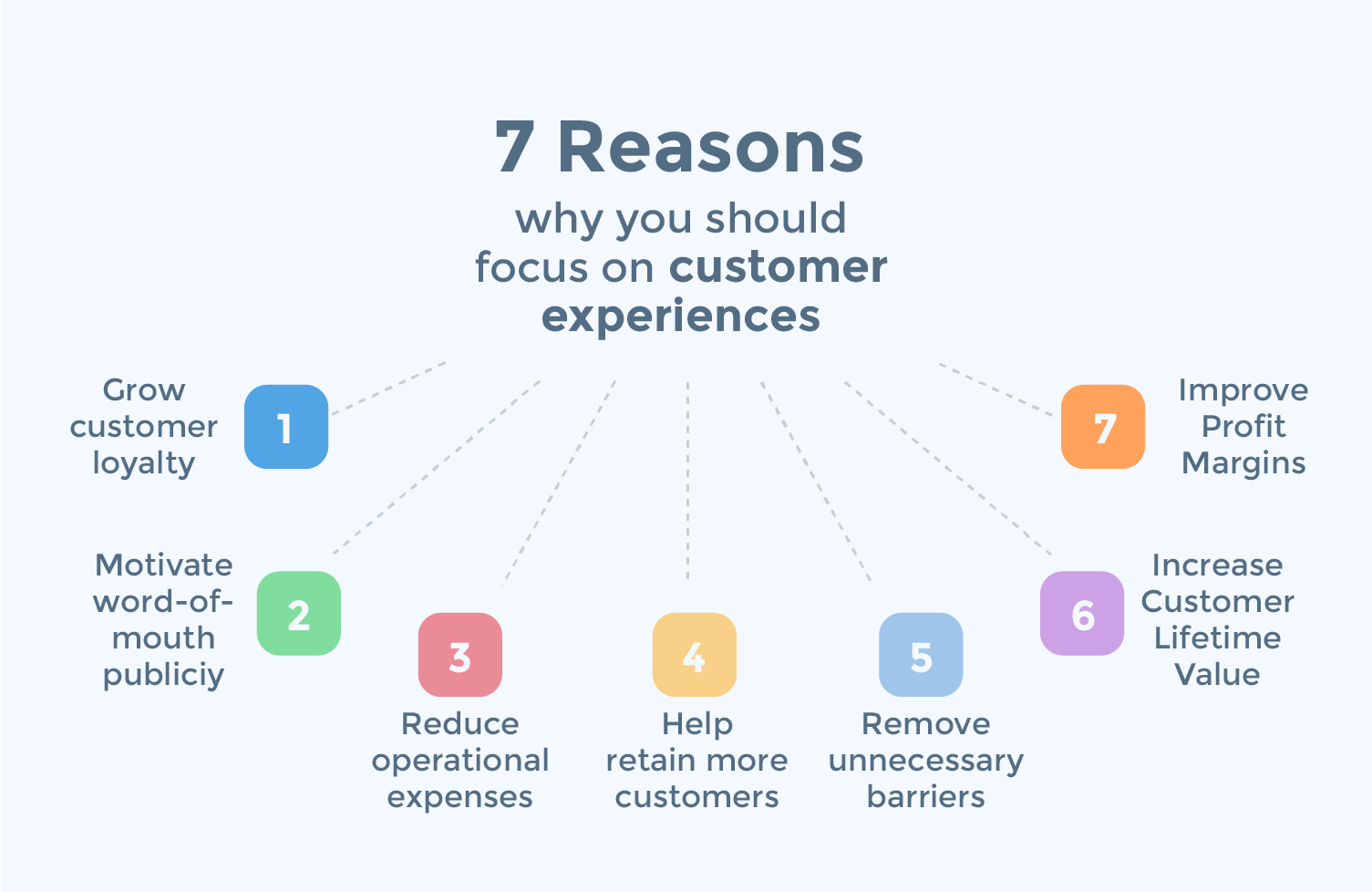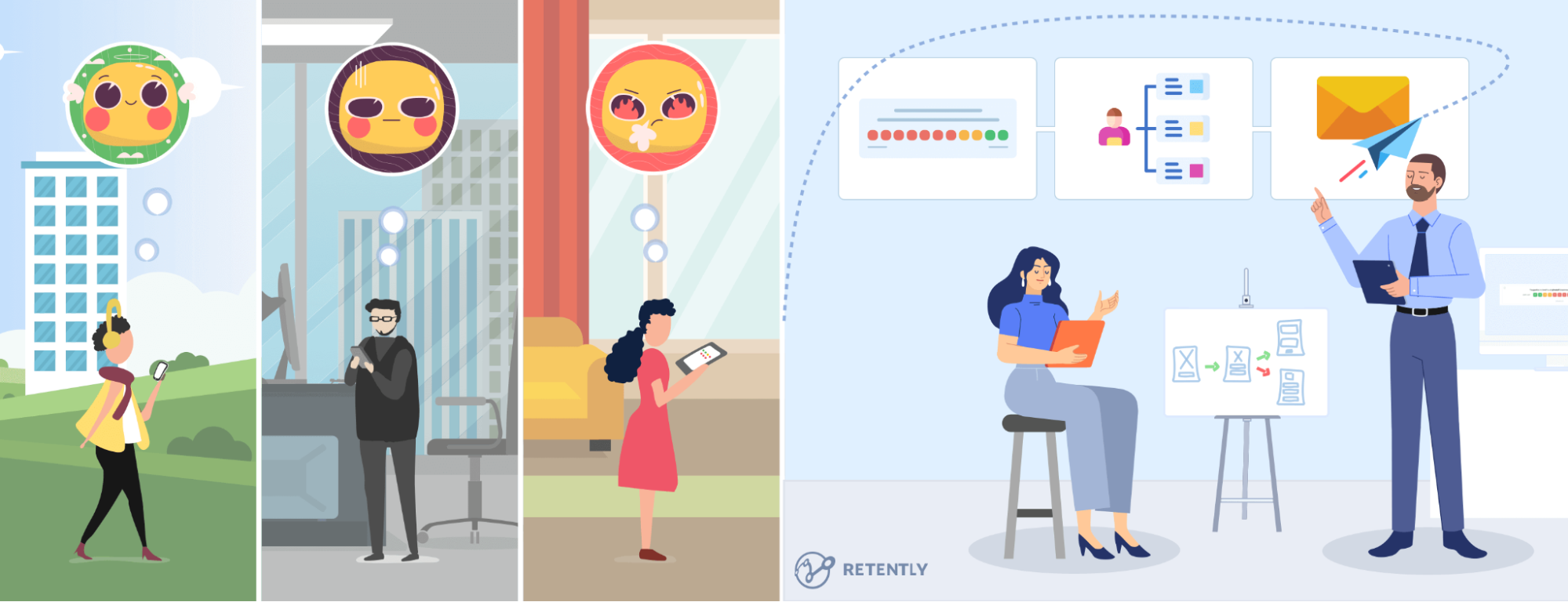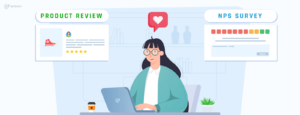“Customers are no longer buying products and services — they are buying experiences delivered via the products and services.” – Gregory Yankelovich
In a world where your potential competitors are just a click away, customer experience is the new marketing battleground. Customers no longer pick brands for individual products or services; instead, they choose the business that delivers the best experiences.
That’s because the price margins between competitive brands have narrowed, services have become standardized and migration costs have been minimized, leaving out just one key differentiator – customer experience (CX).
Unlike customer service, which is serviced on a transaction basis (an after-service call or sales-rep interaction), customer experience is an end-to-end interaction, from content discovery to onboarding and online support. It’s the heart and soul of your brand.
For instance, a call to an Amazon executive to get your problem solved is customer service. At the same time, the whole process of ordering a product and having it delivered to your doorstep with just one click is a customer experience.
Now, despite growing evidence that customers are getting increasingly service-centric, many businesses undermine the importance of having a great customer experience.
An independent research shows that 9 out of 10 Americans are willing to pay a premium for a better customer experience. According to an American Express Survey, 78% of customers bailed on a transaction or did not make an intended purchase solely due to a poor customer experience.
That’s why big brands like Starbucks and Apple invest heavily in creating great customer experiences. It allows them to build brand loyalty while letting them enjoy huge profit margins. Instead of competing on quantitative things (low pricing, higher quantity, etc.), Starbucks and Apple chose to focus on improving the qualitative metrics (empathy, support, look-and-feel, etc.), and that’s exactly what customers want.
Psychological studies suggest that buyers value an emotional connection with the brand and are more likely to do business with you if they know you care for them. According to a McKinsey study, 70% of buying experiences are based solely on how customers feel treated.
Happy customers are also more likely to refer, thereby compounding your growth rate and providing qualitative growth. Great customer experiences (CX) also help reduce marketing costs, improve user engagement and organizational efficiency.
Despite the empirical evidence, businesses often make the mistake of being too calculated and cautious when it comes to going above and beyond to make their customers happy. While they see the operational overheads, they overlook the fact that a single negative customer experience reduces customer loyalty by an average of 20% and the chances of repurchase by 91%.
In this article, we’re going to explain seven strong reasons why customer experience matters and why it is the key competitive differentiator. We’ll discuss how delivering a great customer experience can give you an unparalleled edge over your competitors and how you can capture emotional responses from users to accurately measure the quality of your customer experience.
Key Takeaways
- A great product alone isn’t enough; how customers feel when interacting with your brand determines whether they stay or leave.
- Products and prices can be replicated, but an exceptional experience builds long-term customer relationships that competitors can’t easily match.
- The easier and more enjoyable it is to do business with your brand, the more customers will return and recommend you to others.
- Personalization makes customers feel valued. People expect brands to understand their preferences and anticipate their needs – one-size-fits-all experiences no longer work.
- Happy customers naturally share their experiences, leading to organic growth through word-of-mouth marketing.
- Loyal customers are less price-sensitive. When a brand consistently delivers a great experience, customers are willing to pay more and stay longer.
1. Customer Loyalty is Priceless
“Customer Satisfaction is Worthless. Customer Loyalty is Priceless.” – Jeffrey Gitomer
When a transaction is done right, you make a sale. When a customer is treated right, you make a long-term customer acquisition.
Customer loyalty can be defined as the long-term inclination of customers to stick to your brand, despite existing alternatives. It goes beyond customer satisfaction and can heavily impact how buyers make decisions.
For instance, the Financial Times Advisor notes that even within the banking industry, customer experiences determine long-term relationships and not just customer satisfaction.
It’s worth mentioning that while there are other methods for building brand loyalty, like offering discounts, reduced prices, or giving rewards, they are neither equitable nor sustainable in the long run.
For instance, if your marketing team suggests that slashing your subscription price by 20% could bring a 5% boost in sales, that’s a great move in the short term but harmful in the long term. If your competitors follow up on your move and reduce their prices by 25%, users would have no problem switching, again.
But, when you deliver a great customer experience, users are less likely to switch to other competitors, even if they’re given viable incentives. That’s because customers value the emotional connection with your brand, and believe they will be treated right if they do business with you.
Another factor that plays a crucial role in building brand loyalty is cognitive fluency. Humans tend to prefer things that are simple, familiar and easy-to-use. If the customer experience has been optimized for speed and clarity, while requiring minimal effort from the customer, they’re more likely to stick with it.
And that makes sense, too.
If customers have tried your service and know it works flawlessly, they won’t spend much time researching other alternatives and risking a bad purchase.
That’s why you should focus on getting the first customer experience right because repeat purchases (revenue) and referrals (brand loyalty) depend largely on customers’ first positive buying experience.
2. Word-of-Mouth (WOM) Publicity Beats Everything
Positive customer experiences translate into customer delight and motivate users to talk about your brand to their friends/colleagues. It’s not just free, indirect marketing; it’s credible marketing, too. According to a Nielsen survey, 82% of Americans seek recommendations from friends or colleagues before making a purchase. A different source citing a global survey gives as much as 89% of respondents as trusting personal recommendations.
Unlike traditional marketing channels like advertising, referral marketing has a much better impact and ROI. In another customer survey, Nielsen found that over 60% of customers relied heavily on user reviews before purchasing.
In other words, customers are 50x more likely to buy if they hear a good word about it. This is based on the concept of social proof — a psychological phenomenon where people assume the actions of others in an attempt to reflect the correct behavior.
When you deliver positive customer experiences, you motivate users to share their positive experiences via social media channels and encourage them to talk about your brand to people in their social circle.
Slowly, the flywheel effect of positive word-of-mouth marketing starts providing organic growth to your brand, and you see a huge jump in the number of active users without actually spending a dime on advertising/marketing.
For instance, Airbnb managed to generate a 25% uplift in bookings simply by introducing a referral program and leveraging its word-of-mouth publicity in marketing. They found that referred users tend to be better than the average user, in the sense that they spent more on the platform and were also more likely to refer others.
That’s because, according to the principle of cognitive dissonance, customers who refer your brand to other users are unlikely to switch/refer any other competitive brand, as it makes them inconsistent with their initial set of beliefs.
So, just by creating great customer experiences, you generate positive WOM publicity, which triggers a net positive impact on your sales, reduces the outflow of customers, improves growth rate and increases market reach, while cutting down advertising and other promotional expenses. That’s a solid win-win.
3. Recurring Customer Service Costs Can Be Avoided
Many businesses shy away from going that extra mile to delight customers because they think it adds up a chunk of operational expenses. Marketers are often taught to mislead customers with false information to increase sales numbers. Sales executives are often instructed to close customer queries soon in order to serve more customers.
While such tactics indeed deliver quantitative growth for the short term, they don’t provide qualitative growth for the long term.
For instance, in his book – Customer Experience 3.0, Goodman describes how, at an appliances company, sales reps were trained to rush the customer off the phone to save a minute of rep time (estimated at 50 cents). Such haste resulted in secondary repair expenses of $84 and a second technician visit.
On the other hand, when the sales reps were motivated to ask contextual questions, the second visits were reduced by 30% and customers were more satisfied with the product. It goes on to prove how providing a better customer experience actually reduces operational expenses in the long term and decreases customer dissatisfaction.
A good customer experience is all about reducing the element of unpleasant surprise in business transactions so that there are no recurring after-sales expenses or unpleasant customer grievances.
For instance, crisp, clear and simple content on your website improves conversions and reduces queries to customer support, thereby reducing operational expenses. It also helps customers choose the right product, thereby improving retention and brand loyalty.
But again, it’s important to note that reducing operational expense is not the goal of delivering a great customer experience; it’s the outcome of it.
Sometimes you may need to spend more on improving your customer experience so that you can reduce service costs in the long run.
For example, if you want to deliver a great customer experience, you need to reach them through multiple channels – be it live chat, phone call, email or social media. Because, according to an independent study by the 1st Financial Training Services, a typical business hears from only 4% of its dissatisfied users, and out of those 96% of customers who don’t complain, 91% don’t ever come back, which is a huge loss.
It also means personalizing user experiences so that users have less trouble finding what they need without any external solicitation.
Personalization and Proactive Engagement
So, personalization isn’t just about tailoring products and services but customizing every step of the customer journey. This means sending marketing messages that speak directly to the customer, crafting unique website experiences, and offering customer service that speaks to individual needs. It’s all about delivering the right content to the right person exactly when they need it. Moreover, statistics confirm that companies implementing personalized approaches experience a 40% increase in revenue.
For example, Amazon improves conversions by recommending products based on purchase and browsing history. It adopts a mixed strategy of up-selling and cross-selling products, which not only increases sales but also improves customer satisfaction. It also allows customers to easily return and exchange products without talking to an executive.
If you apply a traditional marketing analogy, this might seem like a harmful move as you’re allowing customers to easily cancel purchases, but numerous studies suggest that it’s exactly what customers want – to be in absolute control.
What’s more, thanks to AI and data-driven insights, businesses can now create hyper-personalized experiences at scale. Here’s how:
- AI-powered recommendations – Suggesting products based on your shopping behavior.
- Dynamic website experiences – Personalized landing pages that adapt to each visitor.
- Smart automation – Chatbots that assist customers instantly, based on past interactions.
- Predictive analytics – Knowing what a customer needs before they even ask.
Take Spotify, for example. Their AI-driven playlists like Discover Weekly and Daily Mix feel tailor-made for each user, strengthening engagement and loyalty.
4. Retaining Customers is Profitable
“The primary reason that makes customers switch to a competitor is a bad customer experience.”
According to the Customer Experience Impact Report (CEI), 89% of customers started doing business with a competitor following a poor customer experience. If you put that statistically, you stand a chance of losing 9 out of 10 dissatisfied customers, which, if realized, could dramatically increase your churn.
Great customer experience helps retain more customers, since they feel comfortable doing a business transaction with the brand and have no motivation to look elsewhere. It also builds up brand loyalty, thereby increasing repeat purchases and order sizes.
For example, Amazon is known for returning price differences in the multiple of a few cents, just so that they can build up intense brand loyalty and retain more customers.
It’s worth noting that delivering great customer experiences does not mean delivering a flawless customer experience. Of course, if you’re going to serve a lot of customers, the complaints will increase, like overcharging customers, for instance. What matters is not the problem itself, but how you choose to listen to the customer and solve that problem.
According to Lee Resources, a customer is 70% more likely to do business with a brand if a complaint is resolved in their favor. In other words, you can retain users even after an occasional goof-up just by being empathetic and attentive to their problem.
If you’re wondering how such empathy turns into profitability, an independent research by Frederick Reichheld of Bain & Company [see the research results in PDF] (the inventor of NPS) states that increasing customer retention by a mere 5% leads to a whopping 25% – 95% jump in profits.
In other words, a customer values the experience a lot more than competitive pricing, heavy discounts, or any other marketing incentives. When they decide to make the next purchase, their decision won’t be affected much by whether you’re offering a great deal, but majorly by how you’re treating them and how they feel about your brand.

5. Remove Unnecessary Barriers
No news is not always good news.
Referring again to the American Express Survey, over 96% of dissatisfied customers don’t voice their complaints because brands create unnecessary barriers between them and customers, making it hard for customers to get a quick resolution.
Often, they do it unknowingly by creating a complicated IVR setup, putting a Contact Us page below the fold, or relying only on emails for complaint resolution.
When businesses don’t hear many complaints from users, they feel they’re delivering a satisfactory experience, but that’s far from the truth. Instead, there are even more frustrated users who feel helpless because they can’t find a quick resolution or have put too much effort into getting their voice heard.
According to a report by Touch Agency, over 1 million people view tweets about customer service every week, out of which roughly 80% of those tweets are negative in nature. Combine it with the fact that it takes 12 positive experiences to make up for one unresolved negative experience, and you have a recipe for disaster.
With more than a billion users now active on social media channels collectively, it’s important to assess the kind of impact that a negative tweet/post can have on your brand’s PR strategy.
Optimizing your customer experience to listen to these complaints and being more empathetic with your customers can dramatically improve customer loyalty and retention. Since users monitor both complaints and brand responses on social media, they get a fair assessment of the response rate as well as complaint resolution.
By making proactive customer resolution part of your customer experience, you mitigate the chances of legal, regulatory or PR disasters, since most cases start as unresolved complaints.
6. Increase Customer Lifetime Value (CLV)
Delivering a great customer experience also increases how much revenue every customer generates for your business. It’s an important metric for businesses, as it gives a straight correlation between the scale of expansion and profitability.
For instance, if you’re growing at a rapid pace and acquiring a large number of users, but none of them are paying users, it’s not a great long-term strategy. CLV (Customer Lifetime Value) allows you to gauge how many users value your brand and how much your newly acquired users are willing to pay.
Unlike growth that can be ‘hacked’, customer lifetime value cannot be manipulated via incentives, since it’s based on repeated purchases and not on a single first purchase. It can only be built by delivering what customers want on a consistent basis.
When you create a great customer experience, you automatically increase your CLV. Customers will not want to shift to other brands, even if given tangible rewards. In other words, you’ll create unconditional brand loyalty.
Moreover, as every customer becomes more valuable, you can afford to provide them with a better service and spend more on acquisition strategies. As per unit economics, as long as CLV (Customer Lifetime Value) > CAC (Customer Acquisition Cost), you have a sustainable business model.
Ideally, you should maximize the gap between CLV and CAC, which means you’ll get more revenue from existing customers and spend less on acquiring new users. And that can only happen when you deliver an experience that customers strive for.
7. Improve Profit Margins
“Growth is vanity. Sales is sanity.”
Amazing customer experiences automatically make the company more profitable, as customer service executives have fewer complaints to solve, lower advertising costs due to positive WOM/referral marketing, and less pain involved in dealing with customer grievances.
Apart from reducing operational costs, having a great customer experience also provides you the flexibility to charge a premium for your services. For instance, Apple sells iPhones at almost 1.5x- 4.5x the price of an Android smartphone and still manages to sell millions of devices while enjoying thick profit margins. Apple makes it possible by solely focusing on delivering extraordinary customer experiences.
According to the rule of reciprocity in social psychology, humans are wired toward paying back what they receive in debt. In cases where they cannot assess the true value of a product, they rely on external signals like product pricing, availability, social proof, etc. to accurately assess its value.
In other words, if you ensure a consistently great customer experience (CE) and charge a premium for that, the users would have no hesitation in paying for it, as they make the decision based on the perceived value of the product rather than the actual value.
… But How Do You Measure Customer Experience?
A report suggests that customer experience was bound to overtake price and product as the key brand differentiator by 2020. In fact, an independent study by Peppers & Rogers Group suggests that 81% of companies adopting high customer-experience maturity are already outperforming their competition.
The tricky part, however, is that, unlike quantitative metrics like CTR, conversions or churn which are easier to track and measure, customer experience is an aggregated sum of the end-to-end experiences, right from content discovery to onboarding and complaint resolution, making it difficult to quantify.
According to statistics provided by Brian and Co, 80% of the companies surveyed said that they deliver a superior customer experience, but only 8% of their customers agreed with them.
Although effective, the Customer Satisfaction Score (CSAT) and Customer Effort Score (CES) can only be used to assess the performance of independent transactional processes. For instance, assessing the quality of a service call or an abandoned transaction can provide actionable insights about improving the overall experience. Yet, they don’t necessarily capture the voice of the customer on how they feel about the brand.
For instance, if a customer is unhappy with an interaction he had with an Amazon executive, it does not necessarily imply that he hates Amazon’s overall shopping experience.
On a comparative note, Net Promoter Score® is a much more reliable metric that allows you to analyze whether people love/hate your brand’s customer experience by just asking them a simple question: “Would you recommend our service to your friends/family?”
What makes NPS® credible is the fact that it’s difficult for people to recommend something they themselves don’t like. Also, since the question is rather open-ended and not directed toward any transaction, customers are more likely to be honest in their feedback.
Using NPS, you can segregate your audience into Promoters, Passives, and Detractors, and combine the analytics with behavioral, transactional and user-specific data to gain insights on how to personalize customer experiences and improve ROI.
Improve Your Net Promoter Score
Transactional interactions are no longer enough. Now, it’s all about building strong customer relationships via unique experiences. Looking back, it’s clear that businesses that succeed are the ones that go above and beyond to understand what their customers want and need, and deliver that at every step of the way.
Prioritizing customer experience has moved beyond a nice-to-have, it’s a must-do strategy that can really make or break a business. What’s more, this customer-centric approach is only going to gain more ground. Businesses will have to keep coming up with new ways to make the customer experience better, leveraging technology, collecting and analyzing customer data for insights, and empowering the team for better outcomes. Even as things keep changing, one thing’s for sure – customer experience is going to remain key for a competitive edge.
Retently makes it easy to keep a pulse on customer sentiment and measure your NPS score. By asking one simple question, you can now get actionable insights on how to improve customer retention, grow revenue, and build long-term customer happiness.



































 Alex Bitca
Alex Bitca 

 Greg Raileanu
Greg Raileanu 

 Christina Sol
Christina Sol 
